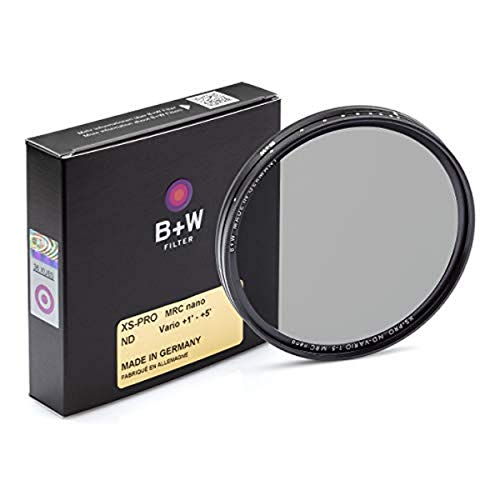[ad_1]
Are you struggling to know variable ND filters and tips on how to choose the greatest variable ND filter?
Then you’ve come to the fitting place.
Because on this article, I’m going to inform you
every thing you want to find out about these filters and their results.

Now, variable ND filters could seem difficult, however they don’t should be. The idea is pretty easy.
With a standard ND filter, you possibly can reduce the quantity of sunshine that reaches your digicam sensor (like placing sun shades over your lens).
But with a variable ND filter, you get to determine how robust you need the darkening
impact to be. You can alter the filter to offer you an ultra-strong impact, or
you flip the filter to realize a comparatively weak impact.
Let’s take a better look:
What is a Variable ND Filter?
A variable ND filter is designed to cut back the
mild hitting your digicam sensor with out altering
the colour. By turning the variable ND filter, you possibly can alter its results–giving
you the choice of working with a weak ND filter or a powerful ND filter,
relying in your wants.
How Variable ND Filters Work
While there are a selection of the way to create variable ND filters, the best entails putting two polarizing filters collectively.
If you organize the polarizers in order that they
work in opposition to at least one one other, you don’t get a polarization impact.
Instead, the polarizers merely block out mild–with the power of the
light-blocking impact dependent upon the best way the polarizers are organized.
As you flip the outer polarizer, the
light-blocking impact will increase or decreases its power.

This is good for photographers on the lookout for a versatile technique to scale back mild ranges. For occasion, for those who’re photographing operating water in the course of the day, you’ll discover {that a} variable ND filter will allow you to scale back your shutter pace considerably, so to create a ravishing blur impact.
Then, as the sunshine modifications, you possibly can improve or lower the ND filter impact, with a purpose to keep the identical shutter pace. You may also use a variable ND filter to make use of a number of completely different shutter speeds for a similar shot (even with a continuing aperture and ISO).
Do Variable ND Filters Produce
Polarizing Effects?
No, variable ND filters don’t produce a
polarizing impact.
While variable ND filters are constructed
utilizing polarizers, they don’t really work
as polarizers.
If you want a polarization impact, you will need to
use a real polarizing filter.
But if you wish to merely scale back mild ranges,
then an ND filter is the best way to go.

Variable ND Filters vs Fixed
While variable ND filters are one technique to
scale back mild transmission, you even have another choice:
Fixed ND filters, which additionally mount in entrance of
your lens, and supply a set quantity of sunshine discount.
Now, fastened ND filters are far much less versatile
than variable ND filters. While a variable ND filter means that you can alter the
quantity of sunshine hitting the sensor, a set ND filter stays fixed. This
means that you will want to hold a number of fastened ND filters if you wish to
match the results of a variable ND filter.
However, fastened ND filters include an enormous
profit:
Quality.
Fixed ND filters are, on common, larger
high quality than their variable ND counterparts. They produce much less vignetting, give
sharper photographs, and don’t have any cross-pattern impact. They’re additionally loads cheaper.
Really, it’s loads just like the query of prime versus zoom lenses:
Do you need the standard of primes, or the
comfort of zooms?
It all is dependent upon your wants and what you’re
keen to sacrifice. If comfort is of key significance to you, then go along with
a variable ND filter. But for those who require the best possible high quality, then a
fastened ND filter is the higher choice.

Do Variable ND Filters Affect
Image Quality?
Technically talking, all filters have an effect on picture high quality–although some filter sorts are a lot worse than others.
Related: Best Lens Filter Brands
Variable ND filters do trigger quite a few
optical issues it’s important to be careful for, particularly if you are going to buy
poor-quality glass.
Vignetting
First, some variable ND filters trigger vignetting. This may be taken care of fairly simply in post-processing, however for those who like to attenuate your time spent behind a pc, you’ll wish to buy the highest-quality variable ND filter you possibly can afford.
Color Shifts
Second, lower-quality variable ND filters
trigger shade shifts. This manifests as a tint throughout your complete picture.
Like vignetting, that is an impact that you simply
can take away in post-processing, so it might be one thing you’re keen to
tolerate.
Cross-Pattern
Third, all variable ND filters trigger an
disagreeable cross-pattern impact at full power.
A big ‘X’ seems throughout the middle of the
picture, and is extraordinarily troublesome to take away in post-processing.
In reality, this is likely one of the greatest drawbacks
to variable ND filters, and you can’t forestall it by buying a
higher-quality filter. So you all the time should be looking out for the
cross-pattern impact when taking pictures.
General Softness
High-quality filters gained’t trigger a lot, if any,
softness.
But if you are going to buy low-quality filters, the
form that price simply ten or twenty {dollars}, you’re going to finish up with very
comfortable photographs.
That’s why I like to recommend buying the perfect
filter you possibly can afford.
Best Variable ND Filter Models
Now let’s check out the perfect variable ND
filters you should buy, irrespective of your price range:
01. Heliopan Variable ND
Heliopan Variable Gray Neutral Density Filter
Heliopan is thought for his or her high-quality
filters, and this variable ND choice is not any exception. You get a 1-6 cease
variable ND impact, permitting you vital flexibility in selecting your
shutter pace. The filter itself makes use of prime quality supplies: brass, for an
extra-durable ring, and Schott glass, for the highest-possible picture high quality.
Unfortunately, the Heliopan Variable ND isn’t low cost–however for those who’re on the lookout for
the best possible high quality, this filter is the best way to go.
02. Tiffen Variable Neutral Density Filter
Tiffen Variable Neutral Density Filter
While the Tiffen Variable ND filter is available in
at one-third the price of the Heliopan Variable ND, its efficiency is
surprisingly robust. The Tiffen Variable ND options top-notch picture high quality
with restricted lack of sharpness, in addition to strong development for long-term
use. You additionally get a broader ND impact in comparison with the Heliopan, from 2 to eight
stops mild discount. The Tiffen Variable ND filter is a good alternative for
anybody trying to spend much less however obtain a picture high quality that rivals extra
costly choices.
03. B+W XS-Pro Digital ND Vario MRC Nano
B+W XS-Pro Digital Vario ND with Multi-Resistant Nano Coating
The B+W XS-Pro Digital ND Vario MRC Nano
filter is neither the most affordable nor the most costly filter on this listing, however
it delivers in all the important thing methods. The filter options wonderful ergonomics,
permitting you to easily transfer all through the vary of ND results. You get
between 1-5 stops of sunshine discount with minimal vignetting and robust picture
high quality; you additionally get a high-quality brass ring to extend sturdiness.
04. NiSi Variable ND Filter
NiSi NIR-VND Variable ND 1.5-5 Stop Filter
The Nisi Variable ND filter isn’t the most well-liked choice in the marketplace, however it’s a strong one, combining an affordable worth with good efficiency. The filter affords a 1.5 to five cease light-reduction impact, and makes use of nano-coated glass to attenuate flare. The NiSi Variable ND filter additionally consists of an easy-to-use design, with dots indicating the power of the ND impact as you rotate the filter. While the NiSi Variable ND filter doesn’t precisely come low cost, it’s what you pay for a high-quality ND filter like this one.
05. PolarPro Variable ND Peter McKinnon Edition
PolarPro 82mm Variable ND Filter (2 to five Stop) – Peter McKinnon Edition
This PolarPro Variable ND comes at a premium
worth, however affords quite a bit for the intense photographer or videographer. You
get a suave design, together with an aluminum ring (painted gold across the aspect).
You additionally get high-quality quartz glass for a minimal vignetting impact. Aside
from its worth, the principle downside of the PolarPro Variable ND filter is its
vary: The normal filter affords solely 2-5 stops of sunshine discount–although you
do have the choice to buy the (costlier) 6-9 cease model.
Conclusion
Now that you simply’ve completed this text, you
ought to know all about variable ND filters:
What they’re.
How they work.
And which one is greatest in your wants.
Variable ND filters are a incredible technique to improve your flexibility within the subject, particularly for panorama photographers, portrait photographers, and videographers.
So if any of the filters we’ve listed attraction
to you, go forward and seize one!
Amazing photographs await.
What to Read Next:








